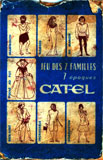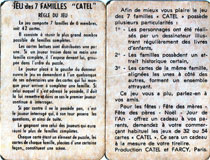We found this card game in France, most likely in Paris, back in 1965. We were traveling on Five Dollars A Day, guided by an early edition of Frommer's original guide book. Even back then we liked the artwork in this game of Seven Families. The goal, as you might imagine, was to collect the most complete families. In France, a family included the same foursome that a family included in America, a father, a mother, a son, and a daughter, but also, the young lovers, a fiancé and a fiancée. If you lined up the cards of a family in the right order, you would build a broader image with the backgrounds linking the family members.
This might well have been the first French family. There is dad, hard at work, and mom, cooking dinner. We're not sure of what critter the cave girl has as her pet, but she too is hard at work at domesticating animals. The Lascaux cave paintings are perhaps 16,000 years old, though the young man's mammoth drawing might date from well before that. |
This isn't exactly a French family, but there they are. Dad is clearly some kind of honcho making his wife a honchess. A Gaul family might have been more appropriate, but there was no reason for such a hackneyed approach, what with Asterix and pals claiming that territory. Ramses, if you are curious, dates from the 13th century before Christ. |
Poule au pot, chicken in a pot, is a reference to Henry IV in the late 16th and early 17th centuries. He reportedly said, "If God spares me, I will ensure that there is no working man in my kingdom who does not have the means to have a chicken in the pot every Sunday!" He was also noted for his religious tolerance, having converted from Calvinism to Catholicism, noting that "Paris is worth a mass". |










